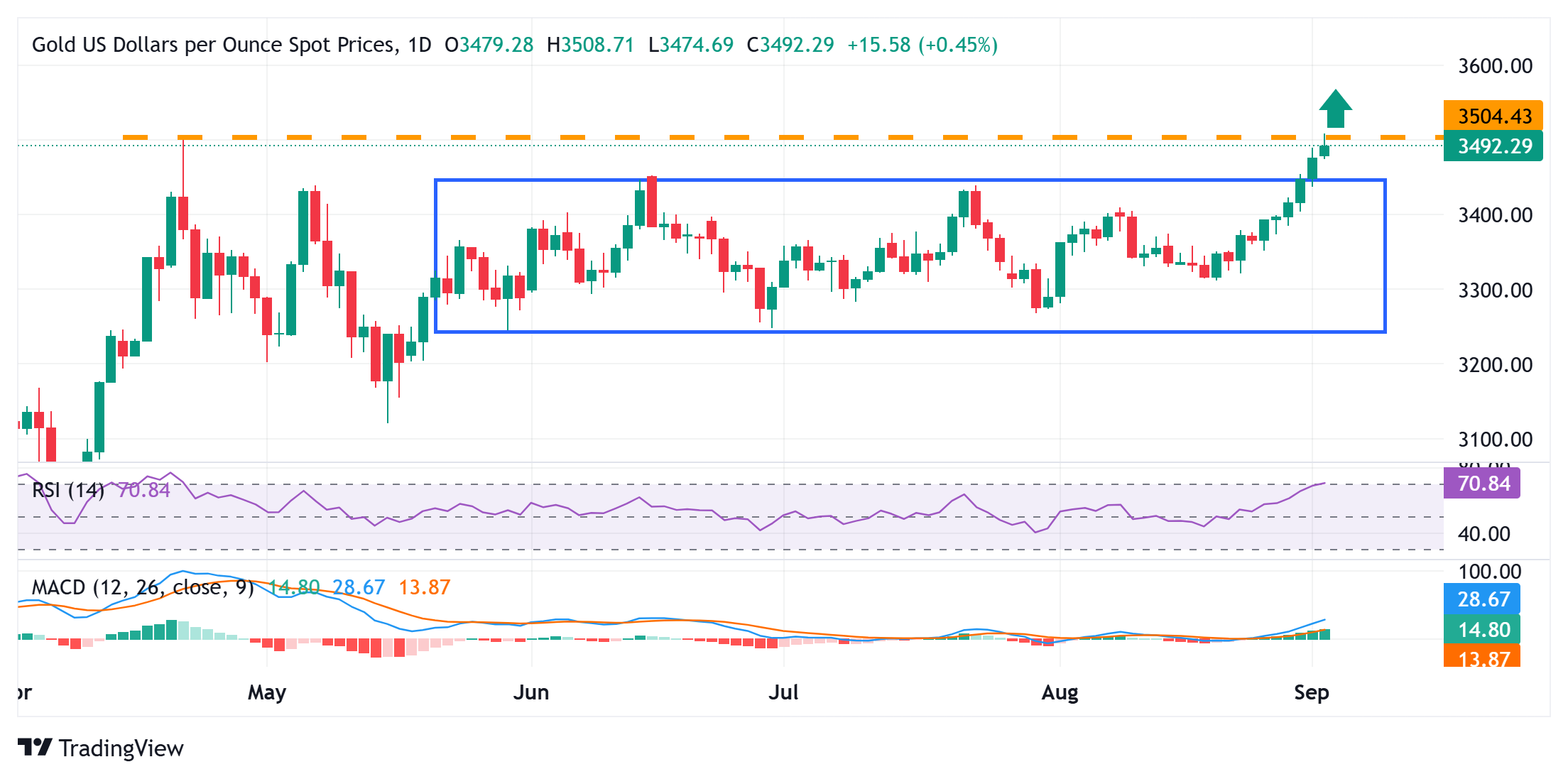Gold struggles to find acceptance above $3,500; retreats slightly from all-time peak
- Gold buying interest remains unabated on the back of rising bets for a September Fed rate cut.
- The US tariffs uncertainty, Fed independence worries, and geopolitics benefit the precious metal.
- A modest USD bounce does little to dent the move up ahead of this week’s US macro releases.
Gold prolongs its uptrend for the sixth straight day and touches a fresh all-time peak during the Asian session on Tuesday. The growing acceptance that the Federal Reserve (Fed) will cut interest rates this month turns out to be a key factor that continues to drive flows towards the non-yielding yellow metal. Apart from this, US tariffs uncertainty and escalating geopolitical tensions turn out to be other factors underpinning the safe-haven bullion.
The XAU/USD pair, however, struggles to find acceptance above the $3,500 psychological mark amid a modest US Dollar (USD) uptick, which tends to undermine demand for the USD-denominated commodity. Moreover, extremely overbought conditions on short-term charts warrant some caution before positioning for any further appreciating move for the Gold price. Investors might also opt to move to the sidelines ahead of this week’s important US macro releases, scheduled at the start of a new month, including the Nonfarm Payrolls (NFP) report on Friday.
Daily Digest Market Movers: Gold continues to benefit from Fed rate cut bets, safe-haven flows
- Rising bets that the Federal Reserve will cut interest rates this month push the Gold price higher for the sixth straight day, to levels beyond the $3,500 psychological mark or a fresh all-time peak during the Asian session on Tuesday.
- US Treasury Secretary Scott Bessent defended US President Donald Trump’s decision to fire Fed Governor Lisa Cook over allegations of mortgage fraud. Moreover, Trump has criticised Fed Chair Jerome Powell for not lowering rates.
- This adds to worries about the Fed’s independence, which might keep a lid on any attempted US Dollar recovery from the vicinity of August monthly swing lows, retested on Monday, and further benefit the non-yielding yellow metal.
- A US federal appeals court ruled on Friday that Trump’s reciprocal tariffs were illegal. Trump has made it clear the next stop will be the Supreme Court, adding a layer of uncertainty in the markets and underpinning the safe-haven bullion.
- An escalation of the conflict between Russia and Ukraine, and in the Middle East, keeps the geopolitical risks in play. This is seen as another factor lending support to the XAU/USD pair and backs the case for a further appreciating move.
- Traders now look forward to important US macro releases scheduled at the beginning of a new month, starting with the ISM Manufacturing PMI on Tuesday, for more cues about the Fed’s rate cut path and a fresh directional impetus.
- This week’s US economic docket also features JOLTS Job Openings on Wednesday, followed by the ADP report on private-sector employment and ISM Services PMI on Thursday, ahead of the Nonfarm Payrolls (NFP) report on Friday.
Gold could consolidate before next leg up amid slightly overbought daily RSI

From a technical perspective, the recent breakout through the $3,440 heavy supply zone, representing the top boundary of a three-month-old trading range, was seen as a key trigger for the XAU/USD bulls. However, the daily Relative Strength Index (RSI) is already flashing slightly overbought conditions, which, along with failure to find acceptance above the $3,500 mark, warrants some caution. Hence, it will be prudent to wait for some near-term consolidation or a modest pullback before positioning for any further gains.
However, any meaningful corrective slide below the $3,475-3,474 area, or the Asian session low, is more likely to attract fresh buyers near the $3,440 resistance breakpoint. The latter should act as a key pivotal point, which, if broken decisively, might prompt some technical selling and drag the Gold price to the next relevant support near the $3,410-3,400 region.
US Dollar Price Today
The table below shows the percentage change of US Dollar (USD) against listed major currencies today. US Dollar was the strongest against the Japanese Yen.
| USD | EUR | GBP | JPY | CAD | AUD | NZD | CHF | |
|---|---|---|---|---|---|---|---|---|
| USD | 0.13% | 0.14% | 0.30% | 0.02% | 0.15% | 0.25% | 0.12% | |
| EUR | -0.13% | 0.00% | 0.19% | -0.11% | 0.06% | 0.10% | -0.01% | |
| GBP | -0.14% | -0.00% | 0.20% | -0.11% | 0.05% | 0.10% | -0.01% | |
| JPY | -0.30% | -0.19% | -0.20% | -0.30% | -0.17% | -0.07% | -0.16% | |
| CAD | -0.02% | 0.11% | 0.11% | 0.30% | 0.10% | 0.24% | 0.10% | |
| AUD | -0.15% | -0.06% | -0.05% | 0.17% | -0.10% | 0.06% | -0.06% | |
| NZD | -0.25% | -0.10% | -0.10% | 0.07% | -0.24% | -0.06% | -0.11% | |
| CHF | -0.12% | 0.00% | 0.00% | 0.16% | -0.10% | 0.06% | 0.11% |
The heat map shows percentage changes of major currencies against each other. The base currency is picked from the left column, while the quote currency is picked from the top row. For example, if you pick the US Dollar from the left column and move along the horizontal line to the Japanese Yen, the percentage change displayed in the box will represent USD (base)/JPY (quote).




